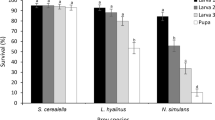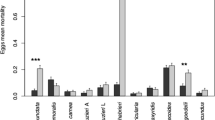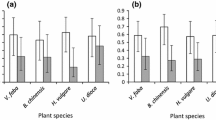Abstract
The predation capacity and prey preference of larvae of Chrysoperla carnea (Stephens) (Neuroptera: Chrysopidae) on eggs or larvae of Pieris brassicae (Linnaeus) (Lepidoptera: Pieridae) in the absence and presence of cabbage aphids as an alternative prey were evaluated in laboratory experiments at 25°C. Both instars preyed upon butterfly eggs and larvae as well as on cabbage aphids with the third instar being the most voracious. The lacewings had a strong preference for caterpillars to butterfly eggs. In the presence of the aphids the predation on P. brassicae eggs or larvae was either completely abandoned or reduced by about 70%, respectively, by second instar lacewings and either reduced by about 80% or maintained, respectively, by third instar lacewings. Both instars thus had a clear preference for aphids compared to eggs of P. brassicae. However, second instar lacewings preferred aphids to caterpillars whereas the opposite was the case for third instar lacewings. The results indicate that 3rd instar C. carnea has a potential as biocontrol agent against P. brassicae.
Similar content being viewed by others
References
Abbott WS (1925) A method of computing the effectiveness of an insecticide. J Econ Entomol 18:265–267
Ables JR, Jones SL, McCommas DW (1978) Response of selected predator species to different densities of Aphis gossypii and Heliothis virescens eggs. Environ Entomol 7:402–404
Auad AM, Carvalho CF, Souza B, Barbosa LR (2003) Biological aspects of Chrysoperla externa (Hagen, 1861) (Neuroptera: Chrysopidae) fed on eggs, larvae of Spodoptera frugiperda (J.E. Smith, 1797) Lepidoptera: Noctuidae. Rev Bras Milho Sorgo 2:106–111
Bakthavatsalam N, Singh SP, Tandon PL, Chaudhary M, Preethi S (2000) Synomone mediated behavioural responses of Chrysoperla carnea (Stephens) (Neuroptera: Chrysopidae) to cotton infested by Helicoverpa armigera (Hübner) (Lepidoptera: Noctuidae). J Biol Control 14:1–6
Biobest (2009) Lacewing for aphid control. http://207.5.17.151/biobest/en/producten/nuttig/chrysopa.htm. Consulted on 29 April 2009
Bioplanet (2009) Chrysoperla carnea. http://www.bioplanet.it/en/bcas/crisopak.php. Consulted on 29 April 2009
Bortoli SA, Murata AT, Narciso RS, Brito CH (2005) Nutritional aspects of Ceraeochrysa cincta Schneider, 1851 (Neuroptera, Chrysopidae), and different preys. Rev Agric (Piracicaba) 80:1–11
Carillo MA, Woolfolk SW, Hutchison WD (2009) Green lacewings. http://www.vegedge.umn.edu/vegpest/beneficials/GLW.htm. Consulted on 29 April 2009
Chen RT, Chen YH, Huang MD (1989) Biology of the green lacewing, Chrysopa boninensis and its predation efficiency on the Citrus leaf miner, Phyllocnistis citrella. In: Guangdong Entomological Institute (ed) Studies on the integrated management of Citrus insect pests. Academic Book & Periodical Press, Guangzhou, pp 96–105
Cock MJW (1978) The assessment of preference. J Anim Ecol 47:805–816
Ding YQ, Chen YP (1986) Predation pattern of the green lacewing, Chrysoperla (Chrysopa) sinica on cotton aphid and cotton bollworm. Chin J Biol Control 2:97–102
Ecole CC, Silva RA, Louzada JN, Moraes JC, Barbosa LR, Ambrogi BG (2002) Predation of eggs, and larvae, and pupae of coffee leaf miner Leucoptera coffeella (Guerin-Meneville & Perrottet, 1842) (Lepidoptera: Lyonetiidae) by Chrysoperla externa (Hagen, 1861) (Neuroptera: Chrysopidae). Ciencia Agrotecnologia 26:318–324
Eigenbrode SD, Moodie S, Castagnola T (1995) Predators mediate host plant resistance to a phytophagous pest in cabbage with glossy leaf wax. Entomol Exp Appl 77:335–342
El-Arnaouty SA, Ferran A, Beyssat-Arnaouty V (1996) Food consumption by Chrysoperla carnea (Stephens) and Chrysoperla sinica (Tjeder) of natural and substitute prey: determination of feeding efficiency (Insecta: Neuroptera: Chrysopidae). In: Canard M, Aspöck, H, Mansell MW (eds) Pure and applied research in neuropterology. Proceedings of the 5th international symposium on neuropterology, Sacco, Toulouse, France, pp 109–117
El-Dakroury MS, Abbas MS, El-Heneidy AH, Awadallah KT (1977) The efficiency of Chrysopa carnea Steph. on eggs and larvae of Heliothis armigera Hb. (Neuroptera: Chrysopidae: Lepidoptera: Noctuidae). Agric Res Rev 55:151–156
Feltwell J (1978) The depredations of the large white butterfly (Pieris brassicae) (Pieridae). J Res Lepidoptera 17:218–225
Hunter CD (1997) Suppliers of beneficial organisms in North America. California Environmental Protection Agency, Department of Pesticide Regulation, Sacramento, pp 1–32
Kabissa JC, Yarro JG, Kayumbo HY, Juliano SA (1996) Functional responses of two chrysopid predators feeding on Helicoverpa armigera (Lep.: Noctuidae) and Aphis gossypii (Hom.: Aphididae). Entomophaga 41:141–151
Klingen I, Johansen NS, Hofsvang T (1996) The predation of Chrysoperla carnea (Neurop., Chrysopidae) on eggs and larvae of Mamestra brassicae (Lep., Noctuidae). J Appl Entomol 120:363–367
Landis DA, Wratten SD, Gurr GM (2000) Habitat management to conserve natural enemies of arthropod pests in agriculture. Ann Rev Entomol 45:175–201
Lopez-Arroyo JI, Tauber CA, Tauber MJ (1999) Effects of prey on survival, development, and reproduction of trash-carrying chrysopids (Neuroptera: Ceraeochrysa). Environ Entomol 28:1183–1188
Manly BFJ (1974) A model for certain types of selection experiments. Biometrics 30:281–294
Nordlund DA, Morrison RK (1990) Handling time, prey preference, and functional response for Chrysoperla rufilabris in the laboratory. Entomol Exp Appl 57:237–242
Obrycki JJ, Hamid MN, Sajap AS, Lewis LC (1989) Suitability of corn insect pests for development and survival of Chrysoperla carnea and Chrysopa oculata (Neuroptera: Chrysopidae). Environ Entomol 18:1126–1130
Osman MZ, Selman BJ (1996) Effect of larval diet on the performance of the predator Chrysoperla carnea Stephens (Neuropt., Chrysopidae). J Appl Entomol 120:115–117
Pappas ML, Broufas GD, Koveos DS (2007) Effects of various prey species on development, survival and reproduction of the predatory lacewing Dichochrysa prasina (Neuroptera: Chrysopidae). Biol Control 43:163–170
Parajulee MN, Shrestha RB, Leser JF, Wester DB, Blanco CA (2006) Evaluation of the functional response of selected arthropod predators on bollworm eggs in the laboratory and effect of temperature on their predation efficiency. Environ Entomol 35:379–386
Principi MM, Canard M (1984) Feeding habits. In: Canard M, Séméria Y, New TR (eds) Biology of Chrysopidae: chapter 4: life histories and behavior. Dr W. Junk Publishers, The Hague, pp 76–92
Rajabaskar D (2007) Stage preference and predatory potential of the bug Chrysoperla carnea against jasmine leaf webworm Nausinoe geometralis. J Ecobiol 19:97–99
Rao CN, Shivankar VJ, Shyam S (2003) Predatory potential and development of the green lacewing (Mallada boninensis) on citrus leaf-miner (Phyllocnistis citrella). Indian J Agric Sci 73:60–61
Richman DB, Hemenway RC, Whitcomb WH (1980) Field cage evaluation of predators of the soybean looper, Pseudoplusia includens (Lepidoptera: Noctuidae). Environ Entomol 9:315–317
Ridgway RL, Jones SL (1968) Field-cage release of Chrysopa carnea for suppression of populations of the bollworm and the tobacco budworm on cotton. J Econ Entomol 61:892–898
Şengonca Ç, Grooterhorst A (1985) The feeding activity of Chrysoperla carnea (Stephens) on Barathra brassicae L. and Spodoptera littoralis (Boisd.). Z Angew Entomol 100:219–223
Sherratt TN, Harvey IF (1993) Frequency-dependent food selection by arthropods a review. Biol J Linn Soc 48:167–186
Silva GA, Carvalho CF, Souza B (2002) Biological aspects of Chrysoperla externa (Hagen, 1861) (Neuroptera: Chrysopidae) fed on Alabama argillacea (Hübner, 1818) (Lepidoptera: Noctuidae) larvae. Ciencia Agrotecnologia 26:682–698
SPSS (2004) SPSS 13.0 for windows. SPSS Inc, Chicago
Tauber MJ, Tauber CA, Daane KM, Hagen KS (2000) Commercialization of predators: recent lessons from green lacewings (Neuroptera: Chrysopidae: Chrysoperla). Am Entomol 46:26–38
Urbaneja A, Munoz A, Garrido A, Jacas JA (2001) Incidence of Chrysoperla carnea (Stephens) (Neuroptera: Chrysopidae) during the predation of Phyllocnistis citrella Stainton (Lepidoptera: Gracillariidae). Bol Sanid Veg, Plagas 27:65–73
Wang R, Nordlund DA (1994) Use of Chrysoperla spp. (Neuroptera: Chrysopidae) in augmentative release programmes for control of arthropod pests. Biocontrol News Inf 15:51–57
Acknowledgments
This work was a part of a Sino-Danish Science-Technology Cooperation Project supported in part by the Danish International Development Agency (DANIDA), and in part by the National Basic Research Program of China (2006CB102005) and Beijing Nova Program (2003B24). We thank Gitte Christiansen and Steen Meyer for their help in connection with the experiments. In addition we thank Kirsten Jensen for her assistance with language corrections and two anonymous referees, as well as the editors of BioControl for their constructive comments which helped us improve the manuscript.
Author information
Authors and Affiliations
Corresponding author
Additional information
Handling Editor: Patrick De Clercq.
Rights and permissions
About this article
Cite this article
Huang, N., Enkegaard, A. Predation capacity and prey preference of Chrysoperla carnea on Pieris brassicae . BioControl 55, 379–385 (2010). https://doi.org/10.1007/s10526-009-9254-5
Received:
Accepted:
Published:
Issue Date:
DOI: https://doi.org/10.1007/s10526-009-9254-5




